
Бесплатный фрагмент - The Modern Kyrgyz: Who They Are?
Back in the beginning

In April 2012, a one-week visit to China’s capital Beijing gave me the opportunity to take a closer look at the tomb of Genghis Khan’s famous adviser, Eluu Chustsay. Chustsay’s family roots can be traced back to the Kyrgyz tribe of the Kytai who belonged to the Left wing (Chustsay was also widely known by the nickname Longbeard). I also visited to the Tianying tower, a remarkable ancient building erected on behalf of Emperor Liao (Steel) in 1120. By the way, Liao also originated from the same tribe historically known as the Kytay or Khitan.
The Tianying tower is known as one of the outstanding masterpieces of world architecture.
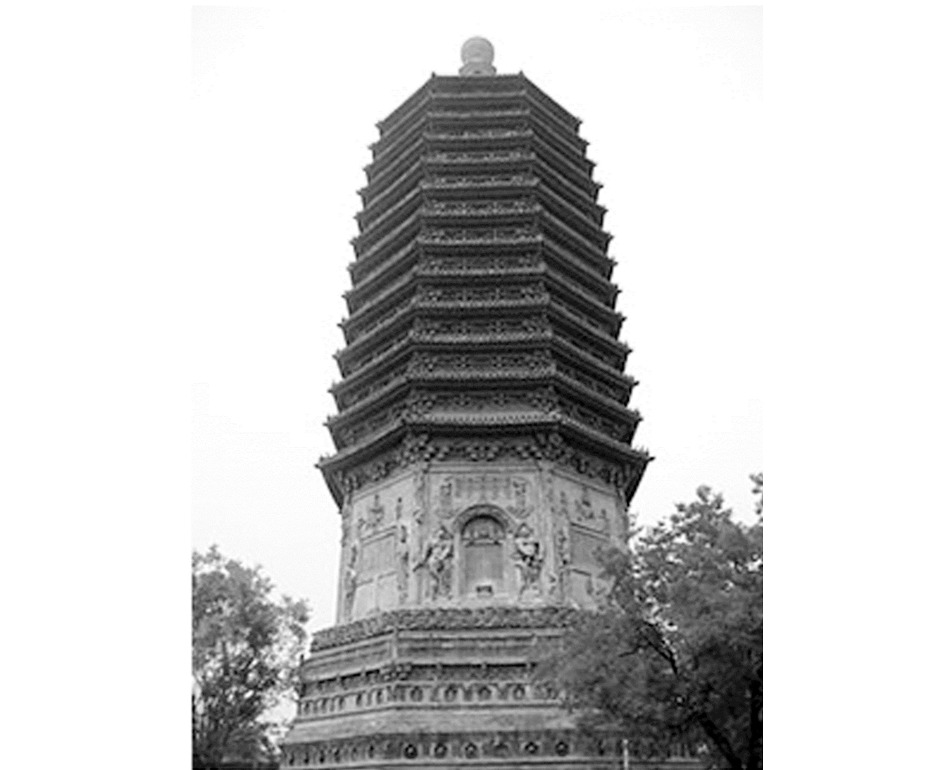
The monument was erected at the burial site of Eluu Tsustsay by the order of Kubilay Khan — the famous descendant of Genghis Khan in 1261. It was set up in the middle of the park of History and Recreation of Ihy Yuan today, which had been established during the reign of the emperors of the Qing dynasty.
The recent historiography of Central Asia has revealed some very interesting ethno-cultural tendencies. Many contemporaries from the region have shown a strong desire to learn more about their history, the Sanzhyra and mythology.
While this pleases me, I would welcome a more honest debate which is guided primarily by authentic historical data and sources, with powerful conclusions drawn on the basis of real findings.

Why is this so important? There are many pseudo scientists and «experts» who do not understand the true history and origins of their tribes. Even so, they consider themselves as professional historians of the Sanzhyrachy and feel sufficiently educated to teach other people on the subject. I would like to appeal to all those who have expressed an interest in such endeavours and encourage them to first learn the history of their own tribes on the basis of impartial historical data.
In so doing, they could prepare the ground for a joint effort in which we could together recreate and restore something really valuable by extracting information from our past treasures — the deep roots of our ancestors and the Kyrgyz nation.
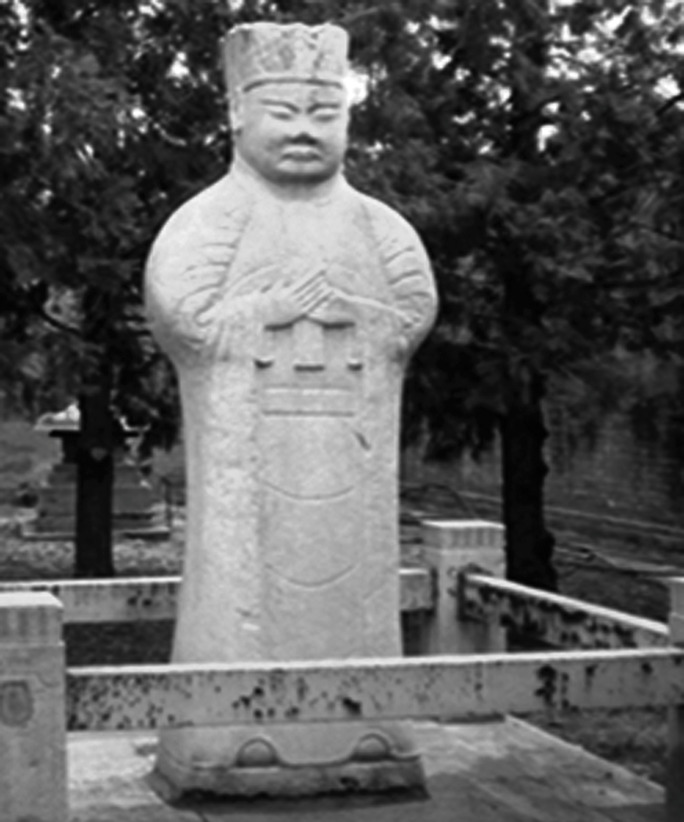
I am deeply fascinated by the history of my tribe, the Kytay and have tried to restore the authentic picture of our past, penetrating and digging to the deep roots and far corner of our mentality and tribal heritage.
In the time preceding this work I turned to Creator, Koko Tengir, the ancient Kyrgyz and Sumerian god, whose spirit is manifest in the nature surrounding us and its great mysteries. I asked for his support and also for assistance from my fathers and forefathers who have left this illusory world a long time ago, as well as from my mother and grandmothers and other relatives from my mother’s side and from my brothers and sisters, all of whom I miss. I hope for their support in my quest to write and document the history of my people.
It is my firm belief that we should use modern historiography and the Sanshyra in order to recreate undistorted fragments and true images of our past identity, thereby enabling us to draw valuable insights from both sides.
Dear readers, in this article I want tell you about the monuments that our ancestors left in Beijing. In my previous works I have provided compelling evidence for the historical fact that Genghis Khan and his adviser Eluu Chustsay originated from the Kyrgyz tribe of the Kytai (Khitan — steel). In this article, I think is useful to bring up new facts and evidence that supported and complement my findings.

In the book «История отечества (History of the Fatherland)», a monograph published in 2000, the prominent Kazakh scientist Kalibek Danyarovwrote:
«In the history of China, Genghis Khan’s origins are interpreted as Chinese, as one who was the representative of the people of China or Kitai same time originated from the Kazakh tribes Kitai, which played a major role in the genesic of China people and empire».
In my book «Who are the Kazakhs really?» I provided a lot of authentic source material clarifying the genesis of our brotherly Kazakh nation.
In fact the basis of the Kazakh people was formed by the same Kyrgyz tribes, the fragments of which later proclaimed themselves as independent tribes and units. These components included the bogozhu-borzhigin, kyira-kyyat, tayalmysh-tayzhuut, kerteney-kereit, kara kesek, tort kara.
In recent years much debate and speculations have surrounded the name of Chingiz Khan. The Chinese considers him as one of their own, connecting his name to the tribe of the Kytai, the Kazakhs did the same thing, announcing themselves as the descendants of the tribe Kytai, while Russians have also believed that their ancestors were the Khitan. Of course, they are all right and make a good point, because Chingiz Khan and his tribe Kytai belong to the Kyrgyz people, and no one denies the fact of kinship between Kazakhs, Chinese and Russian with the Kyrgyz, again thanks to the ancient Kytai tribe.
In the above-mentioned book there is a chapter (page 211, Danyarov) which made the correct conclusion that the Kyrgyz Sarybagysh tribes originate from the Kyrgyz tribe of the Naiman. The Naiman in turn originated from the Khitan tribe, as is shown in Lev Gumilev’s book«Search for an imaginary kingdom» (pages 132,133,170 and 171), on the basis of firm scientific evidence.
Later I will provide own evidence to support this conclusion. It is very important for us to understand that the very name of Kytai is used to describe the Chinese people hanzu, as a direct consequence of the long-term Kyrgyz dominance over China, when many generations of Kyrgyz-originated emperors, mainly from the Kytai tribe ruled that great state. During the longstanding reign of the Khitan tribe emerged such influental and great kingdoms as the Tang, Liao and Western Liao (Central Asia) empires. You will find a lot of material on this subject and convinced yourself for the matter if you type the word Khitan or Kytai, the name of one prominent ancient Kyrgyz tribe, in the Google searching panel.
Many events described in the great Kyrgyz national epos «Manas», which has attitude precisely for that period, when the Kyrgyz emperors arranged his supreme stake in Beijing from where ruled by the great State. Saying that, I here far from the claim that our ancestors Manas lived in Tang era or during the Liao life time. All sources and the evidence suggests that our great ancestor lived in the Bronze Age. I supplied much evidence which proved this fact scientifically in my book «History of the Kyrgyz tribe of Kytai».
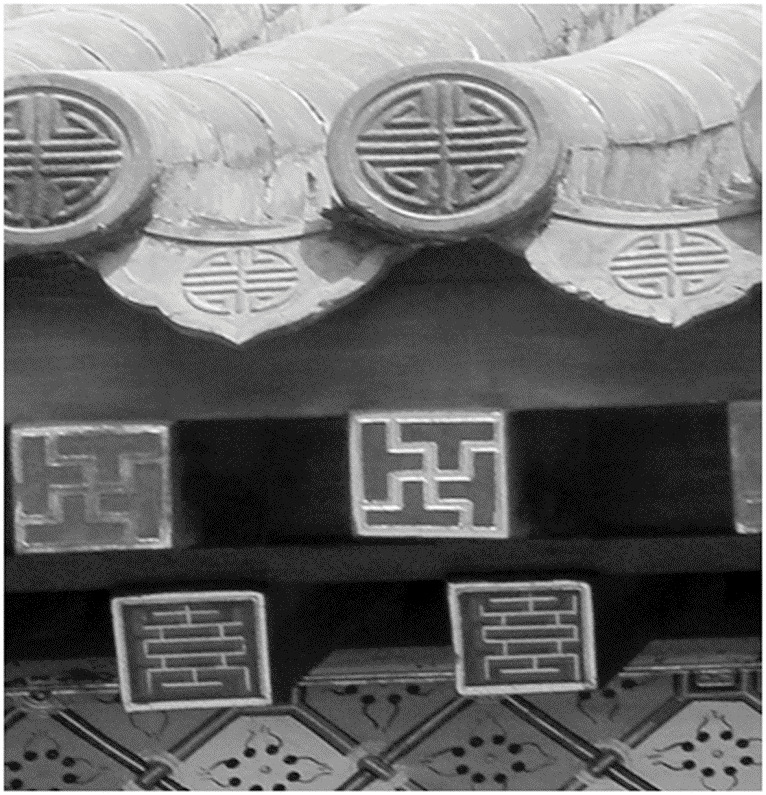
Naturally, many manaschy had only fragmentary information about the Sanzhyra and the multilayered history of our nation, and usually mistakenly confused the epoch in which the real Manas lived with certain historical events and periods that took place much later.
For example, according to the version of «Manas» which belonged to our great manaschy Zhusup Mamai, Akbalta was married his sister Chyiyrdy to Zhakyp. The second wife of Zhakyp Magdum was an Uzbek woman, formerly a widow, and the third wife Bakdolet originated from Tadzhik etnical identiy. These and other features from the family lives of Kyrgys lords clearly testify that the epic story reflected traditions and cultural and historical lings belonged to the XYII century — the epoch when Kalmaks dominated the Kyrgyz.
The same thing applies to the creative art of Sagynbay Orozbak uluu, Sayakbay Karalayev uluu (the famous epos «Manas» interpretators). Meanwhile the statement that Jakyp had married to Chyiyrdy contradicts to the Kyrgyz Sanzhyra, because Kyrgyz ancient traditions strictly prohibited marriage between relatives up to and including the seventh generation.
Obviously, it is in this period that we can observe the influence of Islamic tradition and the effects of its editing practice. This is of little surprise, for many manaschy that lived in the last three to four centuries were exposed to strong influences from religious canons, teachers and patrons, so called Moldo and Eschen.
I would like to draw your attention to a very interesting extract from the book of Kyrgyz sanzhyrachi Saparbek Zakirov«Kyrgyz sanzhyrasy», on page 367, where it is clearly stated how Islamic priests advised our famous poets «to do and write the right thing»:
«Aziz-Kojo, Eschen, in front of Azhyrbek Datka gave the following instructions to Yrchy (psedoname of famous manaschy and poet Balik Ooz): „I ask you and demand from now that you ought not mention in your creations khans and individuals who have not accepted Islam. Only if you sing about and glorify those persons who became Muslims and fought for the great faith, you shell be blessed and fit to go to paradise.“»
Aziz also demanded from the poet to mention as often as possipble the Prophet Kojo Mukanbed (Muhammad) as well as Aziret Aaly Cher, the holy relative of Mukanbed from his paternal side, who was married by the way to the daughter of prophet Fatima. — Approx. AU. And what is more, Aziz openly threatened him, telling him that «if you chant about the last khans who professed Buddhism, then you shall be cursed and your soul will burn in hell.»
Needless to say, the way of thinking, behavior and used words and persuading propaganda of religious fanatics so little change since those times.
After similar instructions Balik Ooz «started to edit and change his version of „Manas“ in regard of the spirit of Islam», as he confessed himself late.
The tradition of marriage between close relatives from paternal and maternal lines was common among Jews and Muslims in ancient times and is often practiced even now in many eastern countries.
For example, the Prophet Ibrahim was married to his paternal sister Saar. The Prophet Mukhambet was married to his sister Kadiche from one forefather and his daughter Fatima was married to the son of his relative Ali.
At the same time, the Tajiks as a nation formed in the VIII eighth century (L.Gumilev «End and beginning again», 101 pp.), and the Uzbeks — in the XVI sixteenth century.
I give evidence to such allegations in my book «Turk Eli Menen Kyrgyz elinin ayrymasy», which is based on scientific sources. Therefore, the wife of Manas Kanykey could not coming up from the daughters of Tajik people, in reality she originated from the Tezhik sub-tribe which in turn was part of the Kyrgyz tribe of the Suu Murun.
For the same reason in the real time of Manas’ reign wars and tensions between the Kyrgyz and Kalmaks never happened. The Kalmaks as an ethnic identity formed much later, in fact this word originated from the Kyrgyz phrase «kalyp galgan el», meaning «people who come to us and left.» The historical name of Kalmaks was Zhungars (Oirots). They inhabited the north-western part of modern China, called the Junggar plain. In the seventeenth and eighteenth centuries they created the Oyrots Khanate and on its base established their own national identity, joining and assimilating also the dinlins, sarts (Uighurs) and Huns.
Many generations of historians and archaeologists have been puzzled to find ancient variations of the Aryan symbol of the Swastika among inscriptions and decorations of various Kumbezes (mausoleums) across Central Asia. You find these astonishing features everywhere and worldwide.
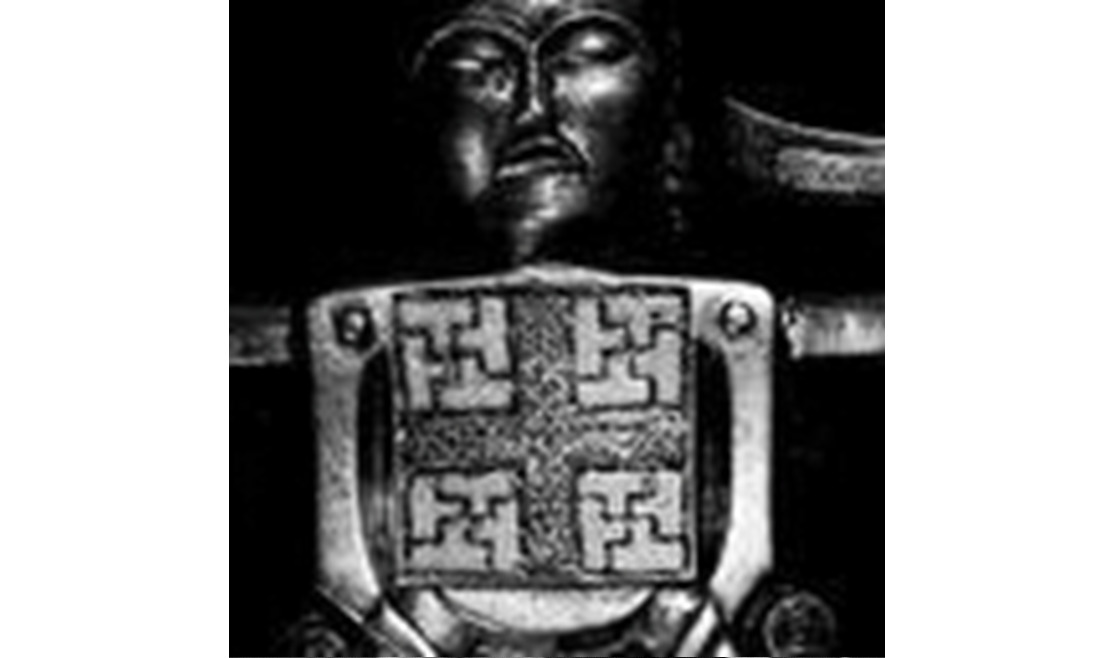
Look at a picture of the famous mosque and mausoleum of Bibi Khanum (Samarqand) or Kalyan Munara (Bukhara), or at the remnants of the palace of Kudayar Khan in Kokand, as well as the tomb of Tamerlane — these ancient buildings are all covered by the same signs.
You can examine these marks and labels yourself if you visit the site «Vedic symbols of Central Asia and Kazakhstan.»
On the photo above you see the picture of a Hittite warrior carved into gold, 3000 years old. The face of the man clearly bears mongolic features. His chest is ornated with the sign that belonged to the Kitai or Kutay, which is also known as the symbol of the Aruu (Aryan) people.
The signs belonged to Aryan civilization and Hitler adopted them as the national symbol of the German Reich, thereby underlining again that the German people belonged to the Aryans. Those who are interested in history will find passages in the work of the ancient Roman historian Cornelius Tacitus about the origins of the German tribes. Tacitus explains that the Kyrgyz and Germans descended from one root. I would also like to refer to the well-known source and Hitler’s famous remarks: «Один раз в год можно будет проводить по столице отряд киргизов, чтобы глядя на ее каменные памятники, они получили представление о мощи и величии Германии». («Once a year it would be possible to lead through our capital the squad of the Kyrgyz and let them look at their stone monuments, and get a glimpse of the power and greatness of Germany»)
These lines clearly indicate that Hitler knew that the Kyrgyz people have a great history and wanted to surpass their achievements. I would like to refer to another historical document dating back to 1810. The German scholar Joseph Gorres wrote in his book «Mythologies of Asian culture»: «European culture is based on Greek culture, which in turn is based on the Asian myth», Kikishev N.I. «Metahistory.»
The photo depicts crosses on the walls which are part of Eluu Chustsay’s tomb. They represent variations of the mark "┬" and its inverted shape "┴». When put together, these marks form the Aryan symbol, the cross, which known around the world.
Why am I drawing your attention on these details of Eluu Chustsay’s tomb? Our ancient forefather Kitay had two sons: the elder was named Baitike or Abaotsi in hanzu language, who was the imperator of Liao (steel), with the tribal mark "┬». The Liao empire reigned from 907—1125 in the same area today known as modern-day China. The second son was named Buudai (with the tribal tamga "┴»). Both symbols can be combined to form the shape of a cross "+».
The genealogy of the Aryans’ symbol originated from the tamgas of the Kyrgyz tribe of the Kitai (kidan) –the marks inherited by the two sons of the forefather of the Kitai.
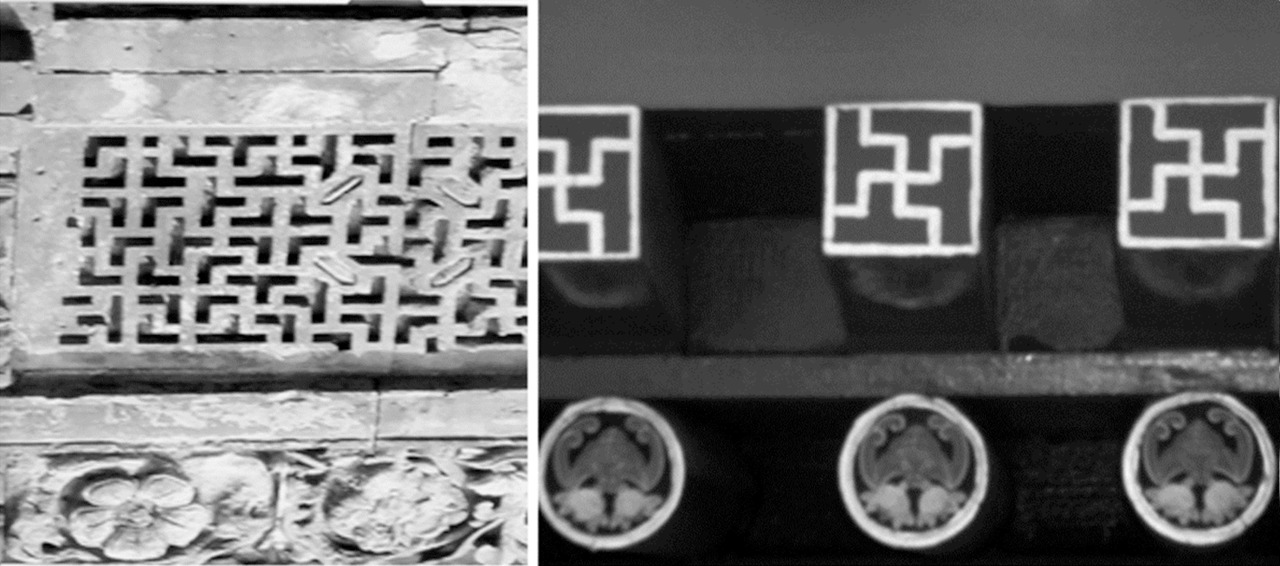
By the way, the Arian symbol of the Swastika has been arranged in two fashions — in clockwise direction (left picture) and in anti-clockwise direction.
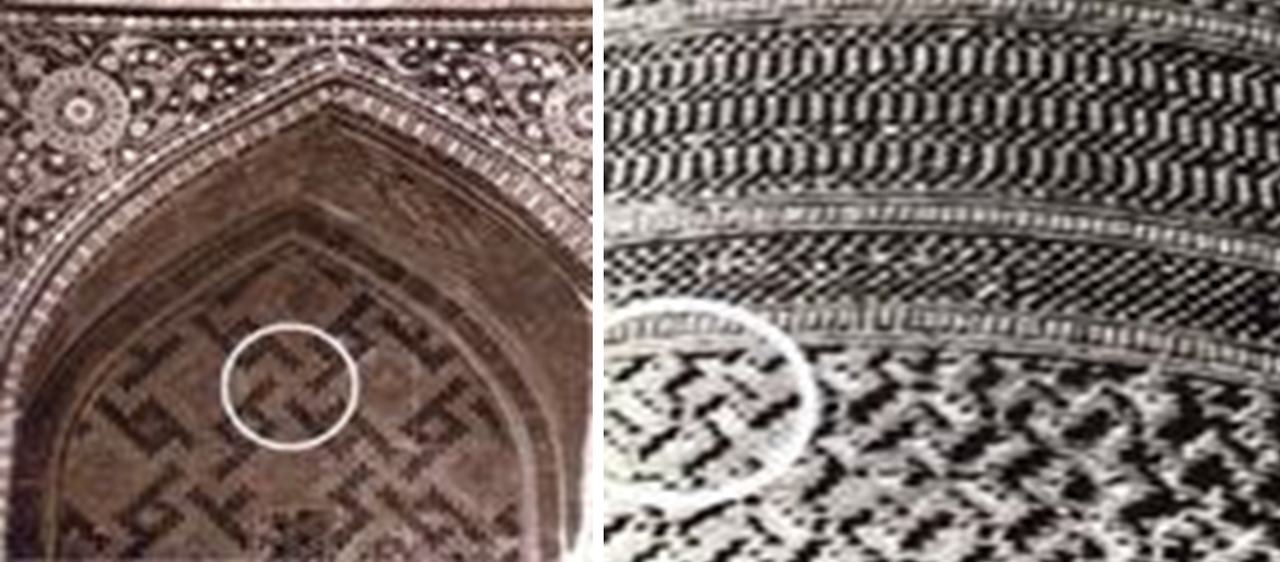
On the pictures we have seen fragments from ancient temples from Buhara and Samarkand.
We can suggest other sources and writings on the subject such as the book by the prominent Kazakh historian A.K. Narymbaevtitled «Turan — the cradle of ancient civilization».
I draw up readers attention to the signs that relevant only to the Kyrgyz clans and originated (created) by their nomadic life-style. Each tribe had its own sign, called tamga, which was used primarily for labeling privately-owned sheep (these marks were burnt on ears of domestic animals) so as to avoid confusion with the grazing «property» belonging to other tribes. Long before people began to lead a sedentary life, they learned farming. And prior to that, ancient men were hunting wild animals and gathering wild berries and fruit.
The tamgas seem to have appeared with the rise of cattle-herding. Their presence on lifestock meant that their owners of animals thus marked belonged to a particular tribe and were freemen with many servants and slaves. Slaves on the other hand did not possess any animals, in fact, they owned no property at all and therefore did not have any tamga.
The tamgas depicted and originated from simple geometric shapes and figures known to the nomadic people since ancient times as round shapes, crosses, cemi-crosses, spears, rhombs, squares, and so on.
In recent years, several famous Kyrgyz citizens or persons with a strong interest in Central Asian history have presented artfully designed fake tribal marks. These usually look very complicated, bordering on the bizarre, and some of them have appeared on kalpaks and coats, enabling their bearers to prominently focus the attention on what they claim is their ancient tamga.
However, such artwork, beautiful though it may be, is quite inconsistent with the available historical data, and often simply defies logic and common sense. How, for instance, was it possible to burn such elaborate designs onto the ears of a sheep or a cow? Ancient tamgas were primarily used to mark private animals and nothing more. Was it possible to imprint on the ears of sheep substantially much more complex figures, something that requires or equals a complex maths equation? While these modern shapes could be considered as interesting sketches in a tattoo studio they have little in common with the ancient tamgas used by our forefathers.
I never wasted my time with such silly activity. As for the shape and meaning of the tamga which belonged to my tribe, the Kytai, I have shown that this mark is supported by historical evidence and data. The tribe of the Kytai (Khitan) consists of eight large Kyrgyz sub-tribes, which later evolved into the independent tribes that formed the basis of the left wing of the Kyrgyz nation (Kytai, Saru, Kushchi, Toboy, Zhetigen, Chon Bagis, Bazys, Munduz).
In previous works I have written about the origin of the name Kytai (Kutai). Here, I would like to mention the historic work «Metahistory» by the Russian author N. Kikishev who wrote about the Sumerians: «The name of the river Kolyma is referred to by its original Sumerian name, Kalama. In the area located between the two rivers Indigirka and Kolyma in Northern Russia, you can find many geographical names that are used to describe hills, slopes, valleys, ridges, furrows etc. which were borrowed for originated from the names of Sumerian gods.»
The Sumerians wrote on the plates of clay (kyt), which were later hardened in fire to the firm tablets. In both Kyrgyz and Sumerian culture this process was well known from ancient times and described as Kalam or Kalamalap, respectively. The people who wrote on these clay tablets belonged to the Aryans, they were called Kyts, kyttar, Kytai by others.
The ancient Hittites founded one of the oldest state in world, and the word Het itself is derived from Kyt-Kytai, hyt-hytay. Some 4,000 years ago they were among the first inhabitants on the European continent to make shields, sabers and various other items produced from iron.
But other part of our ancestors lived in Central Asia. They discovered iron much earlier than the Hittites. In fact, they used a heavenly metal, as they called it to manufacture iron weapons, smelting iron from meteorite remains. This is documented in Y.S. Hudyakov’s work». Thus, the Hittites were members of the Aryan civilization, and our ancestors gave them the secrets and techniques of ancient metallurgy.
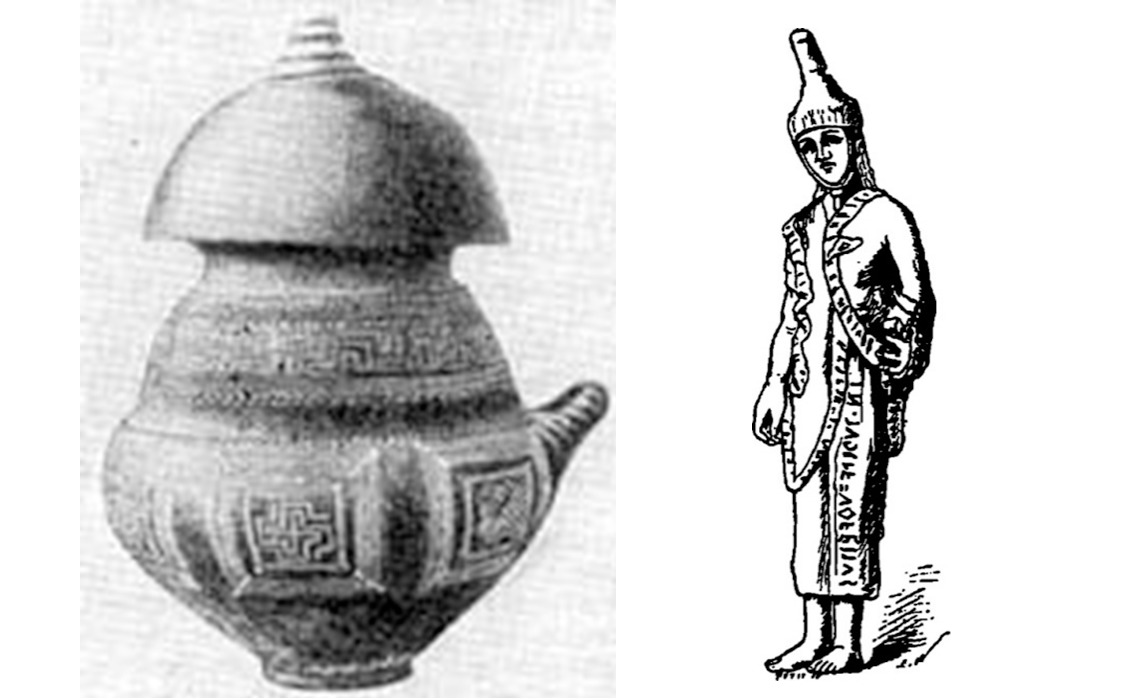
Right: Picture of an Etruscan girl in traditional dress and high cap.

Right: Buranum of the Karachanid empire in Tokmok, Kyrgyzstan, from the tenth century AD.
The Hittites Empire, as it is known, was located on the territory of modern Macedonia and Serbia. Modern Macedonians have written many books revealing that Alexander the Great (Iskander Zulkarnayn) belonged to the clan of the Khitan. The Tocharian state flourished 3000 years ago and the Kushan Empire from the first to the third century AD. The former was located within the modern Xinjiang autonomous Region of China. Both empires were founded by the tribe, belonged to Aryan peoples, who worshiped Tengir and used the specific tamgas — the same ancient marks of the Kytai, Kushchy, Basyz and others.
During archaeological excavations in the «Takla Makan» desert in 1977 many well-preserved mummies were found. Interestingly all male mummies were uncircumcised. In my view this indicates that this civilization’s roots differed from Semitic traditions. It is also known that one mummy called Suluu «Lula» was found with the Aryans signs belonging to the Kytai tribe.
Over the past two thousand years the Kytay tribe created the following powerful empires: Tan (sixth and seventh centuries AD), Liao (fourth to sixth century) Western Liao (twelfth century) as well as the empires of Genghis Khan, Babur, Tamerlane and Kokand Khanate.
Drawing on insights provided in the works by N.Y. Bichurin and L.Gumilev, I wrote several books the on outstanding role played by the Khitans in the era during which the Kyrgyz great power was established in Central Asia, i.e. from 840—960 AD.
It is important to emphasize in this context that the Khitans defeated the strong Uighur state, giving rise to rise the Kyrgyz Khanate. The basis of Kyrgyz Empire then included the following nations: the Kara Kyrgyz, which literally means large backbone Kyrgyz and from whom kings were selected, the Shor Kyrgyz, the Khakas-Kyrgyz, the Tuva-Kyrgyz and the Kyrgyz-Kaisak. The Kara-Kyrgyz themselves were made up of eight Kyrgyz sub-tribes.
A term that has been found to be closely associated with the name of Kytai is Kut which can mean happiness, blessing and star.
The Kyrgyz historian O. Aytymbetov in his famous book «Kara Kyrgyz» suggested that the word Kytai probably originates from the word «Kyt» which means metal alloy. Kyt was usually poured into the Saka, the so called king’s astragal, which seemed much bigger than bones of other animals. Apparently our ancestors greatly valued such things as the astragal, kept them with trepidation, involved them to a lot of traditions, ceremonies and national games. The largest astragal, called chuko in Kyrgyz, was made from a horse bone and called Saka or Royal. It has been associated with the Kara-Kyrgyz tribe, whereas the small chuko, made from a sheep’s bone, has been associated with the smaller Shor, Tuvinians, Khakas, Kyrgyz-Kaysaks tribes. I hope that our relatives will understand us correctly. The word Kara in the Kyrgyz language means big, and Kytai, Khitan make up the core of the Kara-Kyrgyz. This is also evident in the fact that the Khitan means iron, and the name translates as Liao — steel. All these observations indicate that the members of the Kyrgyz tribe of the Kytai had some form of handwriting as well as the necessary knowledge for the production of iron and steel. I have not tried to prove that all achievements and discoveries of mankind can be traced back to my tribe. However, what I am trying to outline are the deep roots of the Kyrgyz nation. I have provided detailed information on the matter in the Sanzhyra of the Kytai based on firm historical materials gathered from various ancient writings. These facts unavoidably lead us to the conclusion that this tribe shaped the core, the kyt or star of Kara-Kyrgyz nation.
Recently, the newspaper «Alibi» featured an article written by the historian N. Nusupov on its website. He suggested to readers that the Khitan allegedly were among the destroyers and enemies of the Kara-Kyrgyz empire, without backing up his claim with firm historical data.
I would like to advise Nusupov and other like-minded historians to carefully study the book «Search for an imaginary kingdom» by L. Gumilev (page 66), another book by the same author with the title «The end and the new beginning», p.117, as well as the book «Kyrgyz jana Kyrgyzstan Tarihi boyuncha tandalma emgekter», written by S. M. Abramzon (pp. 437—438) as well as the works of N. Y. Bichurin.
All these sources clearly show that the Khitan were close relatives of the Kyrgyz. From 704 to 756 AD, the representatives of the Kyrgyz Kytai tribe, more precisely, the Tordosh subtribe, together with other Kyrgyz clans created the great Central Asian state of Tordosh. It controlled areas including such cities as Shasha (Tashkent), Turpan, Beshbalyk, and Jeti-Suu and its capital was the city of Suyab (according with China chronicles, Kyrgyz named it as Ak-Beshim), based close to today’s city of Tokmok in modern Kyrgystan).
The Tordosh state was ruled by the following Khans:
Uchilik, the first king of Tordosh, 699 — 706 AD);
Soge, 706 — 711 AD;
Jen, 711 — 715 AD;
Suluk, 715 — 738 AD;
Kutcha, 738 — 739 AD;
Baga Tarchan, 739 — 742 AD;
Bilge, 742 — 753 AD;
Tenir-Ylmysh, 753 — 756 AD
This state or empire, as it should more aptly be described, maintained close relationships with the Tang empire. This was no coincidence, for the Tang empire was founded by the Kyrgyz Kytai tribe, a fact that I have covered in previous works, based on the research done by L. Gumilev, S. M. Abramzona and other prominent historians and authors.
In recent years, our Kazakh relatives have made considerable efforts in order to prove that the Tordosh state belonged to the Kazakh tribe. However, you will not find any solid evidence for this in historical documents, moreover the Kazakh Sanzhyra does not make any reference to the Tordosh tribe. A growing number of historians have moreover claimed that the Tordosh state was founded by Semites. They suggested that the use of a variant of the modern Turkish term «Turk» — «Turuk» in Kyrgyz, which refers to the practice of circumcision — implied that Tordosh rose under the influence of Arab, Persian kings, who embraced Islam.
However, this is not true, because in that time the eight Kyrgyz subtribes of the Kitay had not yet been Islamized but were adherents of Tengirism.
Бесплатный фрагмент закончился.
Купите книгу, чтобы продолжить чтение.